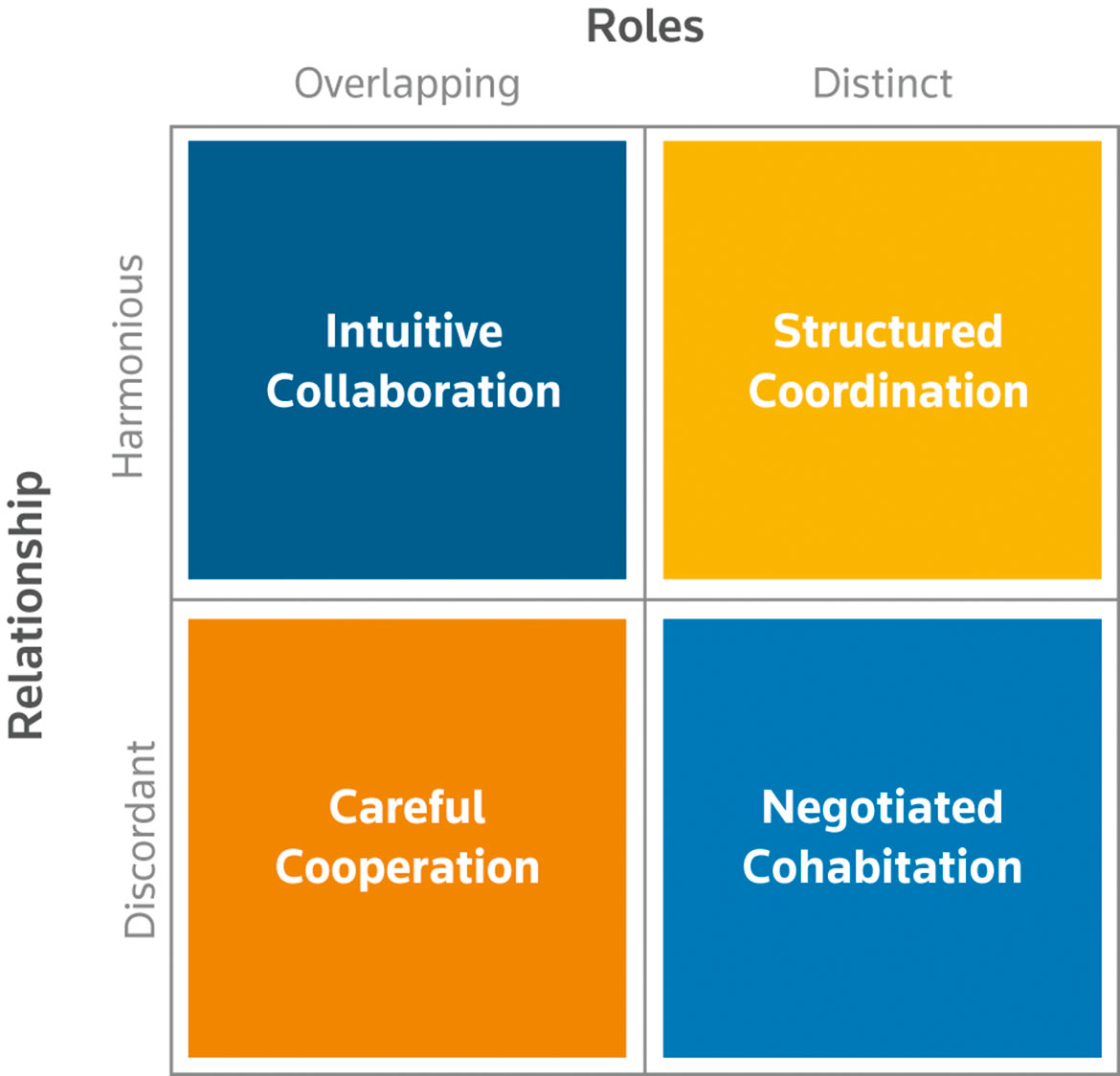Empson: Who’s in charge here?
Managing Partner: Hmmm. You want one name or you want…?
Empson: I just want your view of what the truth is.
Managing Partner: (Pause). I think it’s the two of us actually. We rarely disagree. It’s instinctive.
The dual-leadership model, or leadership dyad, is common in professional service firms. Often it is clear who is in charge, but sometimes it is left deliberately ambiguous, as in the above example from an elite global law firm.
Over the past twenty years of my academic research into professional service firms, I have studied many different combinations and permutations of leadership dyads. The terms themselves — whether senior and managing partner, chair and chief executive, or hybrid combinations such as chair and managing partner — have little inherent meaning because the roles are often defined very differently in different professional firms. What is of interest is how each combination of individuals works out a modus operandi within the leadership dyad.
The Leadership Dyad Framework
In a well-run professional service firm, the leadership dyad should embody and resolve the inherent conflict between the interests of individual partners and the interests of partners as a collective. In embodying this conflict, members of the leadership dyad are able to reduce the extent to which this conflict is enacted within the partnership as a whole.
The figure below illustrates the four key leadership dyads which I have identified through my research across a range of professional service firms.

Leadership dyads in professional service firms
The framework highlights two key dimensions: structural roles and personal relationships. Four distinct leadership dyads are derived from these two dimensions, and I have termed these: intuitive collaboration, structured coordination, negotiated cohabitation and careful cooperation.
We may intuitively assume that separate roles and harmonious relationships will always be optimal (i.e., structured coordination is ideal). However, as the following analysis demonstrates, all four leadership dyads can be either effective or ineffective. The key is to recognize which dyad is being enacted, identify whether it is fit for purpose, and determine whether other more appropriate dyads might be adopted by changing one member of the dyad or re-defining members’ respective roles.
Intuitive Collaboration
Intuitive Collaboration can generate highly successful dyads. The Managing Partner quoted at the start of this article represent an extreme example of the Intuitive Collaboration dyad. Here the relationship is so harmonious that roles overlap almost entirely (the top left quadrant). While it is harmonious, it may still be quite hard work.
In this case, the firm’s governance document states that the roles of Senior and Managing Partner are not defined or distinguished (so that both, in effect, have equal power). Reflecting the ambiguous distribution of formal power, the Senior and Managing Partner struggle with my question of ‘Who’s in charge?’ While the Managing Partner is notionally more concerned with the day-to-day operational issues and the Senior Partner with longer term strategic issues, in practice there is little apparent distinction between their roles.
So, where there is considerable harmony in terms of personal relationship and considerable overlap in terms of role, it is worth considering: What is the point of having two leaders? Is Intuitive Collaboration simply a glorified job share? As the primary purpose of the leadership dyad is to embody and enact conflict within the partnership, the Intuitive Collaboration dyad contains the inherent risk that this harmonious relationship will become ‘group think’, with both individuals in such complete accord that they are unable to identify important issues and fail to take account of conflict within the partnership.
Structured Coordination
In the Structured Coordination dyad (top right quadrant), the members have distinct roles, and the relationship is relatively harmonious.
Some years ago, I worked with a leading international professional service firm who was going through a period of dramatic change. The Managing Partner had been elected on the platform of international expansion; many partners were enthusiastic about his vision for building a highly profitable global firm, but he was feared and resented by those partners who felt most threatened by the reforms he was introducing. By contrast the Senior Partner was very well-liked and seen as the partners’ champion.
The two leaders worked closely together to ensure that the Senior Partner could interpret the Managing Partner’s terse statements, reassure the ‘average’ partners who feared for their jobs, and help those who were asked to leave to do so with dignity. The Senior Partner also could warn the Managing Partner when he was driving the partners too hard, alert him to the more serious signs of partner discontent, and remind him of the need to maintain strong affiliations with the key influencers in the firm.
This combination of distinct roles and harmonious relationship enabled the Managing and Senior Partners to enact effective Structured Coordination.
Negotiated Cohabitation
In the Negotiated Cohabitation dyad (bottom right quadrant), the roles are also distinct but, in contrast to the Structured Coordination dyad, the relationship between the Managing and Senior Partner is relatively discordant.
Superficially, this leadership dyad may appear to have broken down entirely as harmony is maintained by minimizing the contact that they have with each other and by maintaining clearly demarcated roles. Yet Negotiated Cohabitation may in fact represent a pragmatic and highly effective response to a difficult situation.
At one firm I was studying I was involved in a private meeting where the Managing Partner and Senior Partner clashed over a planned management initiative concerning partner appraisals in an attempt to close the gap between high performing and under-performing partners. They argued for more than an hour and the debate became more heated and the criticism more personalized. While the Managing Partner adopted an increasingly threatening posture, the Senior Partner remained quietly spoken and unemotional throughout. By the end of the meeting, they had agreed to delay the initiative for six months. The Senior Partner later told me he felt it was part of his role as Senior Partner to bear the brunt of the Managing Partner’s anger, in spite of the stress it caused him, because it was better for the firm if the Managing Partner raged in private rather than letting his frustration with the partnership leak out into the hallways.
The Negotiated Cohabitation dyad can seem dysfunctional to the outsider and to the members of the dyad themselves. However, as this example shows, it may be highly effective when a professional service firm is grappling with a complex conflict among different factions within the partnership. Sometimes it is the only pragmatic solution.
Careful Cooperation
The fourth leadership dyad, Careful Cooperation, involves a discordant personal relationship and overlapping roles (bottom left quadrant).
In one firm I studied, the Senior Partner took a strongly interventionist approach in the work of the Managing Partner, who was notionally less powerful and did not have a distinct formal power base within the governance structure. They had very differring views on how the firm should be run.
Their relationship was not harmonious but was not allowed to become discordant. In other words, it was a careful collaboration, in which the balance of power was unequal and therefore the discordant relationship had to remain repressed. Thus, some big issues were left unaddressed or skirted around as the two leaders struggled sometimes to communicate effectively, with each other and with the rest of the leadership. They tried hard to appear to present a united front to their colleagues.
While it was far from ideal, this Careful Cooperation dyad was effective. The Senior Partner and Managing Partner managed to work together, carefully and cautiously but effectively, nonetheless. Since they both had been elected to these roles, they did the best they could to make the relationship work.
Conclusion
Senior leadership dyads are widespread among professional service firms and can represent a highly effective method of containing and resolving the conflicts inherent within them. And it is important for leaders to recognize this inherent conflict and seek to embody it rather than shy away from it within the dyad.
Depending on their personalities, the struggle between the members of the leadership dyad may be ferocious at times. But, in having these fights in private and in moving towards a consensus, they are helping to reduce the conflict that will be experienced by the partnership as a whole.






